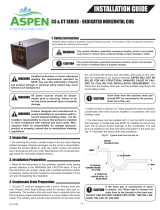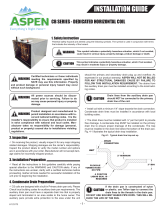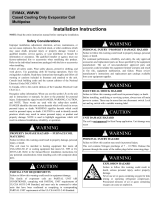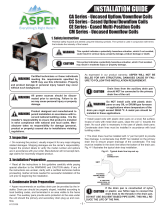
4 18-AD40D1-1C-EN
Installer’s Guide
Condensate drain connections are located in the drain
pan at the bottom of the coil/enclosure assembly. The
female threaded tting protrudes outside of the enclosure
for external connection. A eld fabricated trap is not
required for proper drainage due to the positive pressure
of the furnace; however, it is recommended to prevent
eciency loss of conditioned air.
1. The drain hole in the drain pan must be cleared of all
insulation.
2. Insulate the primary drain line to prevent sweating
where dew point temperatures may be met. (Optional
depending on climate and application needs).
3. Connect the secondary drain to a separate drain
line (no trap is needed in this line). The secondary
drain should terminate in an area easily seen by the
homeowner, but not located to drip on sidewalks or
other slip hazard areas.
4. Test drainage of all condensate lines prior to
completing installation.
5. Install coils with the drain pan and/or casing on
a at, level surface. Slope the coil 1/4'' towards
the drain. Condensate lines must be installed in
accordance with building codes. It is the contractor's
responsibility to ensure proper condesate drainage at
the time of the installation.
IMPORTANT:
Plug all drain line connection(s) not used. Do NOT
use heat or torch near drain ttings.
H. DUCT CONNECTIONS
The supply and return air duct should be connected
to the unit with a ame retardant duct connectors.
Duct ange connections are provided at both supply
and discharge openings of the coil.
CAP OR PLUG
Trap must be within 4'
of furnace / air handler
condensate drain connection.
Close as possible
3. Swedge using approved industry practices, or use
eld supplied coupler, on indoor unit coil connections.
Connect eld supplied refrigerant tubing to coil
connections.
4. Flow a small amount of nitrogen through the tubing
while brazing.
5. Use good brazing technique to make leakproof joints.
6. Minimize the use of sharp 90 degree bends.
7. Insulate the suction line and its ttings.
8. Do NOT allow un-insulated lines to come into contact
with each other.
F. LEAK CHECK
1. Using a manifold gauge, connect an external supply
of dry nitrogen to the gauge port on the liquid line.
2. Pressurize the connecting lines and indoor coil to
150 PSIG maximum.
3. Leak check brazed line connections using soap
bubbles. Repair leaks (if any) after relieving pressure.
4. Evacuate and charge the system per the instructions
packaged with the outdoor unit.
G. CONDENSATE DRAIN PIPING
(SEE FIGURE 3)
NOTE:
When coils are installed above ceilings or in other
locations where damage from condensate overow
may occur, a eld fabricated auxiliary drain pan
shall be installed under the coil enclosure. Drain
lines from this pan must be installed, but should
NOT be connected to the primary pan. These drain
lines should terminate in an area easily seen by the
homeowner, but not located to drip on sidewalks or
other slip hazard areas.
FIELD FABRICATED TRAP
③
There is only a holding charge of dry air in the indoor coil,
therefore no loss of operating refrigerant charge occurs
when the sealing plugs are removed.
1. Remove sealing plugs and use pipe cutter to remove
spun closed ends.
2. Field supplied tubing should be cut square, round
and free of burrs at the connecting end. Clean the
tubing to prevent contaminants from entering the
system.











